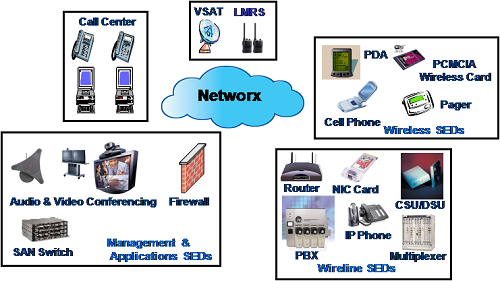A SED is a unit of, or separately priced component within, contractor-provided and owned equipment used to meet the interface requirements for an individual Networx service. In addition, it can be used to implement access aggregation and integration to provide a lower service delivery cost to the Government. A SED may also be a unit of, or separately priced component within, contractor-provided and owned equipment and/or software used to enable the requirements associated with the Management & Applications Services and the Security Services.
A SED will only be offered as needed to provide delivery of a service that is acquired under the Networx contract.
Unless otherwise specifically agreed to by the Government, a SED includes all equipment (hardware, firmware, and software) needed within the contractor's network to provide a Networx service (e.g., any wireline access arrangement-implementing equipment, such as a SONET access arrangement Add/ Drop Multiplexer (ADM)). Any equipment at the contractor's Point of Presence (POP) or equipment otherwise within the contractor's backbone transport network (i.e., POP to POP) is part of the Networx service (access and/or transport service) and thus is not considered as a SED.
A SED could be of the following technology-based categories:
In addition, a SED could be physically a:
The diagram below shows different types of SEDs for different Networx service types.

SEDs are numerous and their technical details vary widely based on customers' diverse requirements for connecting to Networx services. Therefore, it is impractical to provide specific technical details in this document for all SEDs available on the Networx contract.
In addition, SEDs will continue to evolve over the life of the Networx contract, and newer SEDs will replace older SEDs.
For more information on the general SEDs specifications and requirements, please refer to Section C.2.1.7 of the Networx contract for a technical description and Section B.4 for additional information and the pricing structure.
A Service Enabling Device (SED) is equipment used to meet the requirements for an individual Networx service. A SED is provided only as needed to deliver a service that is acquired under the Networx contracts. Unless otherwise specifically agreed to by the Government, all equipment (hardware, firmware, and software) needed within the contractor's network to provide service is part of the access and/or transport service and is not to be separately priced as a SED. Pricing for the same SED may vary by its installed geographic location (i.e., domestic (CONUS), domestic (by OCONUS Jurisdiction), and non-domestic (by Country/Jurisdiction)).
A SED is generally either (1) a stand-alone unit or (2) a packaged unit. However, for pricing purposes, a SED is identified by its separately priced components, as described below. SEDs pricing includes separate CLINs for the following SED Types:
Additionally, for pricing purposes, the priced components for a SED are placed in one of four separate technology-related pricing sections:
Price components required for SEDs comprise some or all of the following:
Deinstallation of contractor-owned devices installed on the customer's premises (a fixed location), including storage, packaging for shipment, and/or transportation, are provided by the contractor at no additional charge to the Government.
Example 1: Wireline Cisco 2811 Router for a CONUS location:
There are two ways to find prices for the above SED:
In this example, all Networx Universal and Enterprise contractors provide the following SED prices for CLIN 990125 (Cisco 2811) with the noted exceptions:
For more information on the general SEDs specifications and requirements, please refer to Section C.2.1.7 of the Networx contract for a technical description and Section B.4 for additional information on the pricing structure.